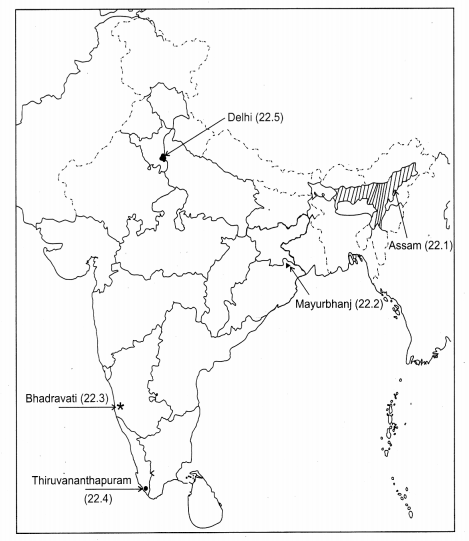CBSE Previous Year Question Papers Class 12 Geography 2018
Time allowed : 3 hours
Maximum marks: 70
General Instructions :
- There are 22 questions in all.
- All questions are compulsory.
- Question number 1 to 7 are very short-answer questions carrying 1 mark each. Answer to each of these questions should not exceed 40
- Question numbers 8 to 13 are short-answer questions carrying 3 marks each. Answer to each of these questions should not exceed 80-100 words.
- Question numbers 14 to 20 are long-answer questions carrying 5 marks each. Answer to each of these questions should not exceed 150
- Question numbers 21 to 22 are related to identification or locating and labelling of geographical features on maps, carrying 5 marks each.
- Outline maps of the World and India provided to you must be attached within your answer-book.
- Use of templates or stencils for drawing outline maps is allowed.
Question 1.
Differentiate between growth and development. [1]
Answer:
Growth is a quantitative concept and value neutral while development is a qualitative concept and value positive always.
Question 2.
Why is India a popular tourist destination in the world ? [1]
Answer:
India is a popular tourist destination in the world because it has a rich cultural heritage.
Question 3.
Evaluate the importance of ‘quaternary activities’. [1]
Answer:
Quaternary activities are centred around research, development and may be seen as an
advanced form of services involving specialised knowledge, technical skills and administrative, competence. These have replaced all primary and secondary activities as the basis of economic growth.
Question 4.
Examine the concept of ‘regional planning’. [1]
Answer:
Regional planning deals with the efficient placement of land-use activities, infrastructure and settlement growth across a larger area of land than an individual city or town to reduce regional imbalance in the development.
Question 5.
Mention any two factors responsible for the establishment of cotton textile mills in I Mumbai. [1/2 + 1/2 = 1]
Answer:
Two factors responsible for the establishment of cotton textile mills in Mumbai are :
- Close proximity to the cotton producing areas of Gujarat and Maharashtra.
- Humid climate and cheap, abundant labour and port facilities at Mumbai.
Question 6.
State the major problem being faced by Kolkata sea-port. [1]
Answer:
Kolkata sea-port faces a major problem of silt accumulation of Hugh river which provides
a link to the sea.
Question 7.
State any two advantages of air transport in the international trade. [1/2 + 1/2 = 1]
Answer:
Two advantages of air transport in the international trade are as follows :
- Air transport is the fastest means of transportation and is preferred for long distance travel.
- Valuable cargo can be carried quickly and safely anywhere.
Question 8.
“The primitive communities lived in complete harmony with their natural environment and as such the humans were naturalised.” Support the statement. [3]
Answer:
The primitive communities lived in harmony with their natural environment and as such
the humans were naturalised because the people begin to understand their environment and the forces of nature with the passage of time. With social and cultural development, humans develop better and more efficient technology. They move from a state of necessity to a state of freedom. They create possibilities with the resources obtained from the environment. The human activities create cultural landscape. The imprints of human activities are created everywhere, giving rise to possibilities. Hence, in the similar sense, an interaction exists between primitive human society and nature, called as environmental determinism. This is why, humans were naturalised.
Question 9.
Differentiate between small scale manufacturing and large scale manufacturing. [3]
Answer:
|
Small Scale Industries |
Large Scale Industries |
| (i) These industries use local raw material, simple power driven machines and semiskilled labour. | These industries involve a large market, various raw materials, enormous energy, specialised workers and advanced technology. |
| (ii) They provide employment and raise local purchasing power. | They are diffused in different parts of the world and provide employment with mass production and huge capital. |
| (iii) Small scale industries use skilled and semiskilled labour. |
Large scale industries use skilled labour.
|
Question 10.
Describe any three major problems of road transport in the world. [3 × 1 = 3]
Answer:
Three major problems of road transport are :
- Road transport doesn’t have a wider reach.
- About half of the roads are unmetalled and this limits their usage and service during the rainy season.
-
Disrespect to the traffic rules is the major problem. Roads suffer from chronic traffic congestion, thus causing delay.
Thus, these are the major three problems of road transport in India.
Question 11.
“Every January after the harvest season ‘Jonbell Mela’ takes place in Jagiroad, 35 kilometres away from Guwahati and it is possibly the only fair in India, where ‘barter system’ is still alive. A big market is organised during this fair and people from various tribes and communities exchange their products.”
In the light of the above paragraph, justify the values of ‘barter system’ in the lives of tribal communities. [3]
Answer:
Barter system is still prevalent in the lives of Tribal Communities due to the following reasons : Barter system fosters mutual cooperation, goodwill and welfare and wellbeing of communities. It is also known as C-C economy. Many tribes practice this system because it’s still acceptable in’ such societies. They have no choice other than to exchange goods for goods. As stated in paragraph, every January after the harvest season, a big market in Guwahati is organised where various tribes and communities exchange their products. In some communities, it is a cultural activity as well.
Question 12.
Study the diagram given below and answer the questions that follow : [3]
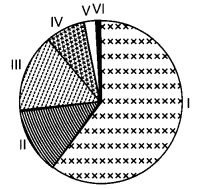
Question 12.1.
Which class of towns/cities support largest urban population ?
Answer:
Class I (61.48%).
Question 12.2.
Explain any two reasons for such a high concentration of population in this class of towns/cities.
Answer:
There is such a high concentration of population in this class of cities because these are metropolitan cities and possess high growth rate.
Question 13.
“Indiscriminate use of water by increasing population and industrial expansion has led to degradation of the quality of water considerably.” Evaluate the statement. [3]
Answer:
Indiscriminate use of water by an increasing population and industrial expansion has led to degradation of the quality of water considerably. This can be evaluated by the following points :
- Human beings pollute the water through industrial, agricultural and cultural activities.
- Among all, industries are the most significant waste contributor.
- Most of the industrial wastes are disposed off in running water or lakes. Consequently, poisonous elements reach the reservoirs, rivers and other water bodies, which destroy the bio-system of these waters.
Question 14.
Define the term ‘density of population’.
Explain four geographical factors affecting the distribution of population in the world, with examples. [1 + 4 = 5]
Answer:
Population density is defined as the number of persons that occupy a fixed area of land (square kilometer). Population density is an important index that shows the concentration of population in a specific area. A simple method to calculate the density of the population is to divide the total population of an area by the total area of land in which the population is confined. It is usually, measured in persons per sq. km.

For example, area of region X is 100 sq. km and the population is 1,50,000 persons. The density of population is calculated as :

Four Geographical Factors :
- Availability of Water : It is the most important factor for life. So, people prefer to live in areas where fresh water is available. For eg, people live in New Delhi or nearby areas because they receive fresh water easily.
-
Land Forms : People prefer to live on flat plains and gentle slopes.
Eg.: Most of the Indian population lives in the central plain areas. - Climate : An extreme climate is unfavourable for any living being. Thus, people prefer to live under moderate climatic conditions. For eg., people in India, at a higher rate live in areas where they find the climate more salubrious and comfortable.
- Soil : Fertile soils are important for agricultural and allied activities. Thus, this is the reason why so many people live in the states like Punjab and Haryana.
Question 15.
“Gathering and hunting are the primitive economic activities meant for the subsistence of tribal societies, but in modem times gathering is market oriented and has become commercial.” Examine the statement. [5]
Answer:
Primitive societies depend on wild animals and edible plants for their survival. Gathering and hunting are such old economic activities. These are carried out at different levels in different orientations.
Gathering is practised in regions with harsh climatic conditions. It often involves primitive societies, who extract both plants and animals for their survival.
It is practised in high latitude zones which include Northern Canada, Northern Eurasia and Southern Chile and low latitude zones such as the Amazon Basin, etc.
In modern times, gathering is market oriented and has commercial value due to the following reasons :
- Gatherers collect valuable plants such as leaves, barks of trees and medicinal plants and after simple processing sell the products in the market.
- They use various parts of plants, for example, the bark is used for quinine, tanin extract and cork leaves supply materials for beverages, drugs, cosmetics, fibres, thatch and fabrics, nuts for food and oils and tree trunk yielding rubber, balata, gums and resins.
Question 16.
Study the following map of the Suez Canal carefully and answer the questions that follows:
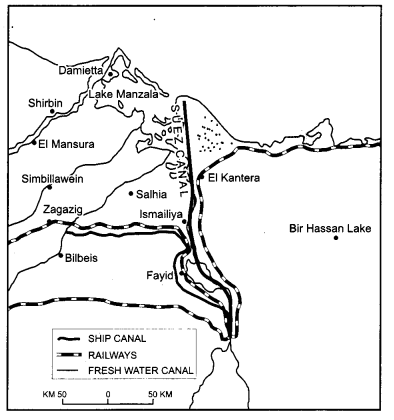
16.1. Name the country through which this canal passes.
16.2. Name the seas connected by this canal.
16.3. Why is the canal considered a gateway of Europe to the Indian ocean ? [1 + 1 + 3 = 5]
Answer:
(i) This canal passes through Egypt.
(ii) Mediterreanean Sea and Red sea.
(iii) This canal is considered a gateway of Europe to the Indian ocean because it gives way to European ships into the Indian ocean and reduces the sea-route distance between Liverpool and Colombo compared to the Cape of Good Hope route.
Question 17.
“The decadal and annual growth rates of population in India are both very high and steadily increasing over time.” Substantiate the statement. [5]
Answer:
Growth of population is the change in the number of people living in a particular area between two points of time. Its rate is expressed in percentage. The decadal and annual growth rates of population in India are both very high and rapidly increasing over time.
- The annual growth rate is 2.4%.
- It is estimated that the country’s population will double itself in the next 36 years and will even surpass China.
- The growth rate of population in India over the past one century has been affected by annual birth rate, death rate and rate of migration.
There are four phases :
Phase I : 1901-1921 : Period of stagnant phase of growth of India’s population.
Phase II : 1921-51 : Period of steady growth of India’s population.
Phase III : 1951-1981 : Population explosion in India.
Phase IV : 1981 till present : Population growth remained high.
Question 18.
Explain how ‘watershed management’ and ‘rainwater harvesting’ are the methods of efficient management and conservation of surface water resources in India. [5]
Answer:
Watershed management and rainwater harvesting are the major methods of efficient management and conservation of surface water resources in India.
(i) Rainwater Harvesting : Rainwater harvesting is a method to capture and store rainwater for various uses. It is also used to recharge groundwater acquifers. It is a low cost and eco-friendly technique, for preserving every drop of water by guiding the rain water to bore well, pits- and wells.
For e.g., Tankas or small tanks.
(ii) Watershed Management: It basically refers to efficient management and conservation of surface and groundwater sources. It involves prevention of runoff and storage and recharge of ground water through various methods like tanks, wells, etc. The success of watershed development, largely, depends upon community participation. ‘Haryali’ is a watershed development project of the Central Govt.
There is a wide scope to use rainwater harvesting technique to conserve the precious water resources. Therefore, both the methods are very efficient.
Question 19.
“The non-conventional sources of energy will provide more sustained, eco-friendly and cheaper energy if the initial cost is taken care of.” Examine the statement. [5]
Answer:
The non-conventional sources of energy will provide more sustained, eco-friendly and cheaper energy if the initial cost is taken care of.
Non-conventional sources of energy are: Sustainable energy resources like solar, wind and bio-mass. Some are enlisted below :
-
Solar Energy : Sun rays trapped in photovoltaic cells can be converted into energy. The two effective processes considered to be very effective to tap solar energy are photovoltaics and solar thermal technology.
- Photovoltaic Solar Technology : It directly converts sunlight into electricity using panels made of semi-conductors cells.
-
Solar Thermal Technology: It captures the sun’s heat. This heat is used directly or converted into mechanical energy and in turn electricity, known as concentrated solar power.
It is cost competitive, environmentally friendly and ‘ easy to construct. The western part of India has greater potential for the development of solar energy in Gujarat and Rajasthan.
- Wind Energy : It is absolutely pollution free, inexhaustible source of energy. The mechanism of energy conversion from blowing wind is simple. India already has started generating wind energy. Thus, such non-conventional sources of energy are eco-friendly and cheaper.
Question 20.
Describe any five characteristics of National Highways of India. [5 × 1 = 5]
Answer:
Highways : The main roads which are constructed and maintained by the Central Government are known as National Highways.
Five characteristics of National Highways of India are :
- National Highways constitute only about 1.7% of the total road network but carry about 40% of the total volume of road traffic. These highways are well connected.
- These highways connect different states.
- These highways are meant for inter-state transport and movement of defence material in strategic areas.
- National highway constitute only 20% of the road length, they carry nearly one-third of the traffic and the World Bank decided to provide loans worth crores US dollars for the development of national highways in six states namely Gujarat, Haryana, Punjab, Tamilnadu, Uttar Pradesh and West Bengal.
- The golden quadrilateral super highway project covers a distance of 5,846 km connecting a number of major cities and towns all over India. It connects Delhi, Mumbai, Chennai and Kolkata.
Question 21.
Identify the five geographical features shown on the given political outline map of the World as A, B, C, D and E and write their correct names on the lines marked near them with the help of the following information :
A. A major sea-port
B. An international airport
C. A major industrial region
D. An important area of nomadic herding
E. A mega city [5×1 = 5]
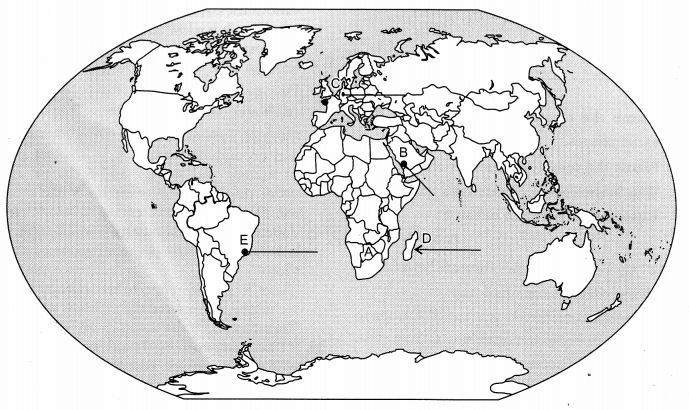
Answer:
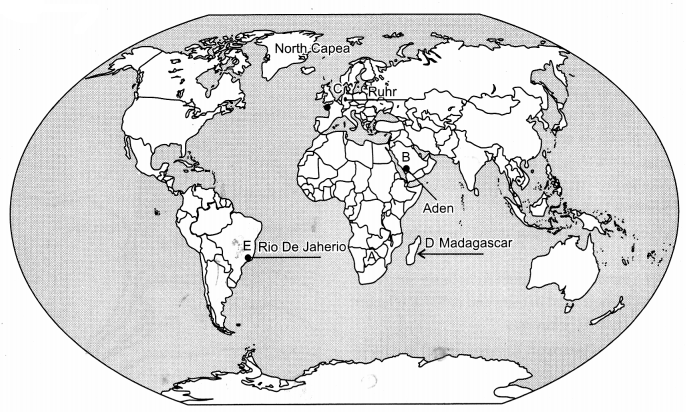
Question 22.
Locate and label the following features with appropriate symbols on the given political map of India. [5 × 1 = 5]
22.1. A major tea growing state
22.2. Mayurbhanj—An area of iron ore mining
22.3. An important steel plant in Karnataka
22.4. An international southernmost airport in Kerala
22.5. A city with a population of more than ten million in North India.
Answer:
